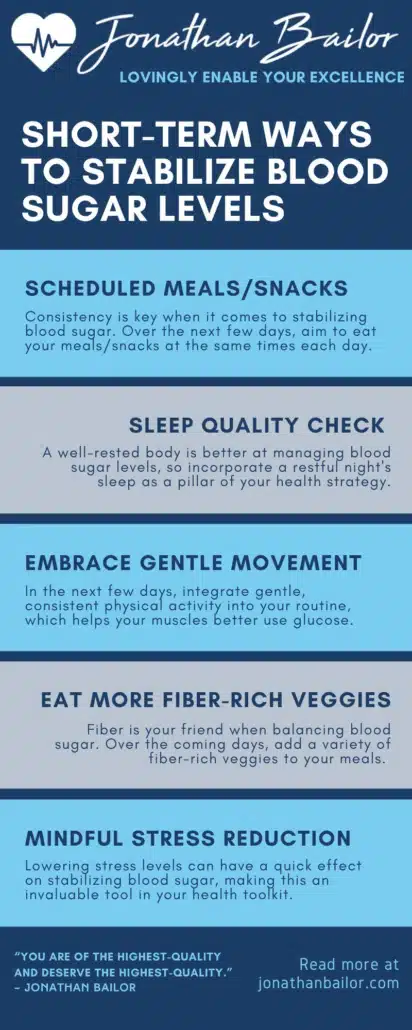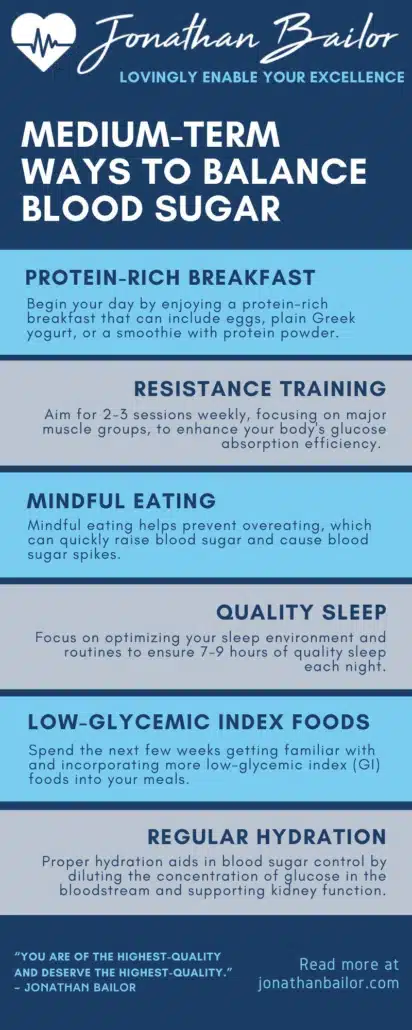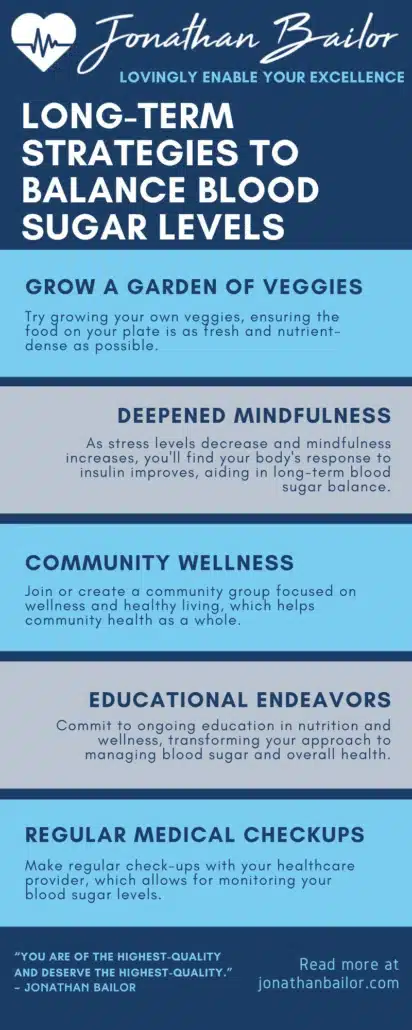20 Ways to Balance Blood Sugar at Every Life Stage
Are you ready to start balancing your blood sugar for ultimate health? This Hormone Health Guide by Jonathan Bailor takes a deep dive into the critical role of blood sugar regulation in health and shows you how to achieve it.
In a world buzzing with the latest diet trends and workout fads, it’s easy to overlook the fundamental elements that govern our health and well-being. One such cornerstone, often hidden in plain sight, is the balance of our blood sugar levels. This isn’t just a topic for those navigating the complexities of diabetes; it’s a universal key to unlocking a vibrant, healthier life for everyone, irrespective of age.
Imagine your body as a finely tuned orchestra, with each instrument playing its part to create a harmonious symphony. When one instrument—like our blood sugar levels—plays out of tune, it’s not just a single note that’s affected. The entire concert of our metabolic health can descend into chaos, affecting everything from our energy levels to how we age. But here’s the good news: with the right knowledge and tools, regulating high blood sugar levels and regaining balance and harmony is within reach.
This guide is your invitation to explore the essential strategies for maintaining healthy blood sugar levels—a beacon of hope for thriving health as the years roll by. It’s about embracing simple yet powerful lifestyle changes that resonate with our bodies’ natural rhythms, ensuring that every stage of life is lived to its fullest, healthiest potential.
Whether you’re seeking to bolster your energy, fine-tune your weight management, or age with grace and vitality, understanding how to master your blood sugar is a step toward a life brimming with health. And the beauty of it? These strategies are grounded in the science of simplicity, making them accessible to everyone, no matter their starting point.
So, let’s take this journey together. It’s time to turn the page and discover the keys to a balanced, vibrant life where every day is an opportunity to feel your best. And remember, this isn’t just about reading; it’s about sharing the wealth of health.
When you find nuggets of wisdom that resonate, please don’t keep them to yourself. Spread the word, share the love, and let’s collectively uplift our health and the well-being of those around us. After all, the journey to optimal health is best traveled with companions by our side.
Immediate Ways to Balance Blood Sugar for Life
In the quest for optimal health, the power lies in the present moment. The choices we make today can immediately impact our well-being, especially when it comes to balancing our blood sugar levels.
Balancing blood sugar is not just a concern for the distant future; it’s a vital part of daily living that can enhance our energy, mood, and overall vitality.
Here are four immediate changes you can make today that don’t require waiting days or weeks to start benefiting from. These simple yet effective adjustments can be the first steps towards a healthier, more balanced life.
1. Hydrate with Wisdom
Starting right now, make water your beverage of choice. Dehydration can subtly affect your blood sugar levels by concentrating the amount of glucose in your blood. By choosing water over sugary drinks or even diet sodas, you’re not only avoiding unnecessary sugar and artificial sweeteners but also helping your body maintain a steady blood sugar level.
If plain water doesn’t excite you, infuse it with slices of lemon, cucumber, or a handful of berries for a refreshing twist that keeps you coming back for more.
2. Mindful Eating
Take a moment to tune into your meals. Eating in a rush or while distracted can lead to overeating, which can make your blood sugar levels rise. Starting with your next meal, commit to sitting down and paying full attention to what you’re eating. Chew slowly, savor each bite, and listen to your body’s fullness signals.
This mindful practice not only enhances your dining experience but also helps prevent the blood sugar spikes that come from consuming more food than your body needs.
3. Smart Snacking
Swap out high-sugar snacks for whole food options rich in fiber and protein. A few nuts, a piece of fruit paired with a slice of cheese, or a small serving of plain Greek yogurt with a dash of cinnamon can regulate blood sugar and keep hunger at bay.
These smart snack choices provide sustained energy without the roller coaster effect that sugary snacks cause. Plus, they’re delicious and can be prepared in advance, making it easy to grab and go.
4. Take a Five-Minute Movement Break
Physical activity is a powerful tool for managing blood glucose levels, and you don’t have to commit to a long workout session to reap the benefits. Stand up from your desk, stretch, and take a brisk five-minute walk around your home or office. These short bursts of activity help your muscles use glucose more effectively, lowering your blood sugar levels in the process.
Make it a habit to incorporate these mini-movement breaks throughout your day, and you’ll be surprised at the difference it makes.
By embracing these immediate changes, you’re not just adjusting your blood sugar levels; you’re setting the foundation for a lifestyle that supports lasting health and vitality. Remember, the journey to wellness comprises small, consistent steps.
Let these immediate actions be the spark that ignites your path to balanced health today and every day.

Feeling Better Is Priceless, That's Why We Don't Put A Price On It!
“It’s Like A Free and Medically Valid Version of Noom and Weight Watchers Online”
~ Dr. Doctor Matthew Oleshiak, MD
Click the 'LEARN MORE' button below for free lifetime access to the fast fix program developed by Jonathan and top Ivy League Medical Doctors
LEARN MOREP.S. It's not a free trial. It's not part of the program for free. The entire program is free, forever, for real! No credit card needed.
Short-Term Steps to Steady Blood Sugar Levels
In the journey to optimal metabolic health, the steps we take in the short term can have a profound impact on our progress. Over the next few days, introducing specific changes into your routine can start to shift the needle towards balanced blood sugar levels and improved well-being. These adjustments are designed to fit seamlessly into your daily life, offering a bridge between immediate actions and the sustainable habits that forge long-term health.
Let’s explore five short-term changes that can positively affect blood sugar levels and set the stage for lasting metabolic harmony.
1. Schedule Your Meals and Snacks
Consistency is key when it comes to stabilizing blood sugar. Over the next few days, aim to eat your meals and snacks at the same times each day. This regularity helps your body anticipate and manage food intake, smoothing out potential blood sugar spikes and valleys.
It’s not about eating by the clock with military precision but finding a rhythm that works for you and sticking to it as closely as possible.
2. Sleep Quality Check
Sleep profoundly influences blood sugar levels. Starting tonight, prioritize getting 7-9 hours of quality sleep. Dim the lights an hour before bed, disconnect from electronic devices, and create a comfortable, soothing sleep environment.
A well-rested body is better at managing blood sugar levels, so consider this your invitation to embrace restful nights as a pillar of your health strategy. Fun fact: getting enough sleep can help you manage your weight as well as regulate blood sugar levels.
3. Embrace Gentle Movement
In the next few days, integrate gentle, consistent physical activity into your routine. Whether it’s a leisurely walk after dinner, a morning yoga session, or simply choosing stairs over elevators, these movements encourage your muscles to use glucose more efficiently.
Think of it as nudging your body towards balance with kindness rather than pushing it with intensity.
4. Experiment with Fiber-Rich Vegetables
Fiber is your friend when balancing blood sugar. Over the coming days, experiment by adding a variety of fiber-rich vegetables to your meals. Try adding spinach to your breakfast omelet, snacking on carrot and celery sticks, or including a side salad with lunch and dinner.
These fiber powerhouses help slow down glucose absorption into your bloodstream, offering a steady, gentle approach to blood sugar management.
5. Mindful Stress Reduction
Stress can send your blood sugar levels on a roller coaster. Over the next few days, dedicate a few minutes each day to a stress-reduction practice that resonates with you. This could be deep breathing exercises, meditation, journaling, or a warm bath.
Lowering stress levels can have a surprisingly quick effect on stabilizing blood sugar as well as reducing your risk of heart disease and high blood pressure, making this an invaluable tool in your health toolkit.
By weaving these short-term strategies into the fabric of your daily life, you’re not just taking steps towards balancing blood sugar; you’re crafting a lifestyle that supports vibrant health at every stage. Remember, the beauty of this journey lies in the power of small, consistent changes to create profound, lasting impacts.

Medium-Term Mastery: Cultivating Balanced Blood Sugar Through Lifelong Habits
As we navigate the landscape of our health journey, embarking on medium-term changes offers a golden opportunity to deepen our commitment to balanced blood sugar and overall well-being. These changes, unfolding over the span of weeks, are like planting seeds in a fertile garden; with a bit of patience and consistent care, they begin to sprout, taking root in the very fabric of our daily lives.
This phase of the journey is about building upon the immediate and short-term shifts we’ve made, layering in practices that enhance their effects and drive us closer to our goals.
Here are several medium-term changes to consider, each designed to harmonize blood sugar levels and enrich your health tapestry.
1. Cultivate a Protein-Rich Breakfast Routine
Begin your day by anchoring your breakfast with protein. Over the next few weeks, experiment with integrating protein sources like eggs, plain Greek yogurt, or a smoothie with protein powder into your morning routine.
This practice helps you avoid low blood sugar, kickstart your metabolism, and stabilize your blood sugar levels from the get-go, setting a balanced tone for the day. It’s a gentle yet powerful way to signal your body that you’re in for a nourished, stable day ahead.
2. Introduce Resistance Training
If you haven’t already, now is the time to introduce resistance training into your weekly routine. Aim for two to three sessions per week, focusing on major muscle groups, to enhance your body’s glucose absorption efficiency. Resistance training boosts muscle mass, which plays a critical role in managing blood sugar levels. Low muscle mass puts you at increased risk of insulin resistance.
This doesn’t require a gym membership or expensive equipment; regular exercise that uses your own body weight or resistance bands offers a great starting point.
3. Explore Mindful Eating Practices
Dedicate the next few weeks to truly embracing mindful eating. This means paying full attention to the experience of eating, savoring each bite, and listening to your body’s hunger and fullness cues. Mindful eating helps prevent overeating, which can quickly raise blood sugar and cause blood sugar spikes.
It’s about creating a harmonious relationship with food, where eating becomes an act of self-care rather than a mindless routine.
4. Prioritize Quality Sleep
Focus on optimizing your sleep environment and routines to ensure 7-9 hours of quality sleep each night. Consider investing in blackout curtains, limiting caffeine intake in the afternoon, and establishing a relaxing pre-sleep ritual.
Sleep profoundly affects metabolic health, including blood sugar regulation. Sleep deprivation has been shown to promote weight gain and health problems. This medium-term commitment can lead to significant improvements in both your energy levels and metabolic balance.
5. Experiment with Low-Glycemic Index Foods
Spend the next few weeks getting familiar with and incorporating more low-glycemic index (GI) foods into your meals. These foods, such as leafy greens, most fruits, legumes, and nuts, have a minimal impact on blood sugar levels.
Experimenting with low-GI foods can be a delightful culinary adventure that steadies your blood sugar and expands your dietary horizons.
6. Embrace Regular Hydration
Make hydration a conscious part of your daily routine. Aim to drink at least 8 cups of water a day, more if you’re active or it’s hot outside. Proper hydration aids in blood sugar control by diluting the concentration of glucose in the bloodstream and supporting kidney function.
Infuse your water with fruits or herbs if you’re looking for a flavor boost.
By weaving these practices into the weeks ahead, you’re not just adjusting your lifestyle for the better; you’re embedding habits that have the power to transform your health in profound ways.
Each step taken is a step closer to a life of balanced blood sugar levels, vibrant energy, and deep, lasting well-being.

Long-Term Landscapes: Sculpting a Future of Balanced Blood Sugar
As we journey further into the realms of health and wellness, embracing long-term changes becomes akin to charting a course for uncharted territories, where the treasures of balanced blood sugar and metabolic health await. These changes, unfolding over months, are the bricks and mortar of the fortress we build to protect and nurture our well-being.
It’s about setting our sights on the horizon, where the fruits of our dedication bloom in full. These long-term commitments are not just adjustments to our daily lives but are profound transformations that engrain wellness into the fabric of our existence.
Let’s explore the enduring changes that can sculpt a landscape of health that stands the test of time.
1. Cultivate a Garden of Nutritious Foods
Now is the time to launch the rewarding journey of growing your own vegetables and herbs. This long-term project not only connects you with the very essence of nutrition but also ensures that the food on your plate is as fresh and nutrient-dense as possible.
Tending to a garden encourages a deeper understanding and appreciation of whole foods, reinforcing your commitment to balanced meals that lower your blood sugar. Plus, the physical activity involved in gardening is a joyful way to exercise regularly, further enhancing your metabolic health.
2. Develop a Deepened Mindfulness Practice
Mindfulness extends beyond the plate; it’s a way of being that can profoundly influence all aspects of health, including blood sugar regulation. Commit to deepening your mindfulness practice over the coming months by exploring meditation, guided breathing, or yoga.
As stress levels decrease and mindfulness increases, you’ll find your body’s response to insulin improves, aiding in long-term blood sugar balance. This journey towards inner peace not only steadies your blood sugar but enriches your life with a serenity that transcends the dining table.
3. Engage in Community Wellness
Join or create a community group focused on wellness and healthy living. Whether it’s a walking club, a healthy recipe exchange group, or a gardening collective, engaging with others on a similar path magnifies your efforts and embeds them into a broader context of communal health.
Over months, this collective endeavor not only fosters a supportive environment for maintaining balanced blood sugar levels but also reinforces the importance of social connections for overall well-being.
4. Embrace Educational Endeavors
Commit to ongoing education in nutrition and wellness. Whether through books, courses, workshops, or seminars, expanding your knowledge over the months can transform your approach to managing blood sugar and overall health.
This continuous learning journey empowers you with the tools and insights needed to navigate the complexities of metabolic health, ensuring that your strategies evolve as science advances.
5. Prioritize Consistent Medical Check-ups
Make regular check-ups with your healthcare provider a cornerstone of your long-term health strategy. These consistent touchpoints allow for monitoring your blood sugar levels, hormonal health, and metabolic markers, providing valuable insights that can guide your lifestyle choices.
Over time, this proactive approach to health care ensures that your efforts are both effective and aligned with your body’s changing needs.
By weaving these long-term changes into the tapestry of your life, you’re not just altering habits; you’re starting on a transformative journey that promises a future where balanced blood sugar and vibrant health are the cornerstones of your existence. This is the path to a life lived fully, richly, and with wellness at heart.

Harmonizing Hormone Health: Your Questions Answered
1. What are the key hormones that influence our health?
Our bodies are orchestrated by a symphony of hormones, each playing a unique role in maintaining our health. Key players include insulin, which is responsible for regulating blood sugar levels; thyroid hormones, which govern metabolism; cortisol, the stress hormone; sex hormones like estrogen and testosterone, which affect reproductive health and mood; and leptin and ghrelin, which influence appetite and satiety. Balancing these hormones is essential for optimal health, affecting everything from energy levels to weight management.
2. How does diet affect hormone health?
Diet plays a foundational role in hormone health. Consuming a balanced diet rich in whole foods can support hormonal balance. For instance, fiber-rich foods help regulate insulin and blood sugar levels, while healthy fats are crucial for synthesizing and balancing sex hormones. Eating insoluble fiber aids your digestive system, while soluble fiber helps lower cholesterol and provides a wealth of other health benefits. Additionally, lean proteins support the production and function of hormones like growth hormones. Avoiding excessive sugar and processed foods is also key, as they can disrupt hormonal equilibrium, leading to issues such as insulin resistance.
3. Can lifestyle changes improve hormone health?
Absolutely. Beyond diet, healthy lifestyle factors significantly impact hormone health. Regular physical activity can improve insulin sensitivity, boost mood-enhancing hormones like serotonin, and reduce stress hormones like cortisol. Adequate sleep is crucial for maintaining a healthy balance of hormones, including those related to stress, hunger, and metabolism. Managing stress through practices like meditation, yoga, or deep breathing can also help regulate cortisol levels, promoting hormonal harmony.
4. What are common signs of hormonal imbalance?
Signs of hormonal imbalance can vary widely depending on which hormones are affected but often include fatigue, unexplained weight gain or loss, mood swings, insomnia, low libido, and changes in appetite. Women may experience irregular menstrual cycles, while men might notice decreased muscle mass. Since these symptoms can stem from various causes, consulting with a healthcare provider for a proper diagnosis is essential.
5. How can I get my hormone levels checked?
If you suspect a hormonal imbalance, the first step is to consult with your healthcare provider. They can order specific blood tests to measure the levels of various hormones in your body, such as thyroid hormones, cortisol, estrogen, testosterone, and insulin. These tests are typically conducted at certain times of the day or month to account for natural fluctuations. Based on the results, your healthcare provider can recommend appropriate treatments or lifestyle adjustments to restore balance.
Understanding hormone health is pivotal to nurturing your body and enhancing your well-being. By embracing a holistic approach that encompasses a balanced diet, regular physical activity, adequate rest, and stress management, you can support your hormonal health and unlock a more vibrant, balanced life.
Embracing a Future of Balanced Wellness
As we conclude our journey through the intricacies of blood sugar balance and hormonal health, we hope you feel equipped with the knowledge to navigate the path toward optimal well-being. These insights are not just beacons guiding us to healthier lives; they’re seeds of change meant to be shared far and wide. Imagine the impact of spreading this wisdom within your circle and beyond.
We invite you to share this piece with friends and family across all social media platforms and via email. Let’s cultivate a community rooted in health, knowledge, and collective empowerment, setting the stage for a future where wellness flourishes.
Feeling Better Is Priceless, That's Why We Don't Put A Price On It!
“It’s Like A Free and Medically Valid Version of Noom and Weight Watchers Online”
~ Dr. Doctor Matthew Oleshiak, MD
Click the 'LEARN MORE' button below for free lifetime access to the fast fix program developed by Jonathan and top Ivy League Medical Doctors
LEARN MOREP.S. It's not a free trial. It's not part of the program for free. The entire program is free, forever, for real! No credit card needed.




